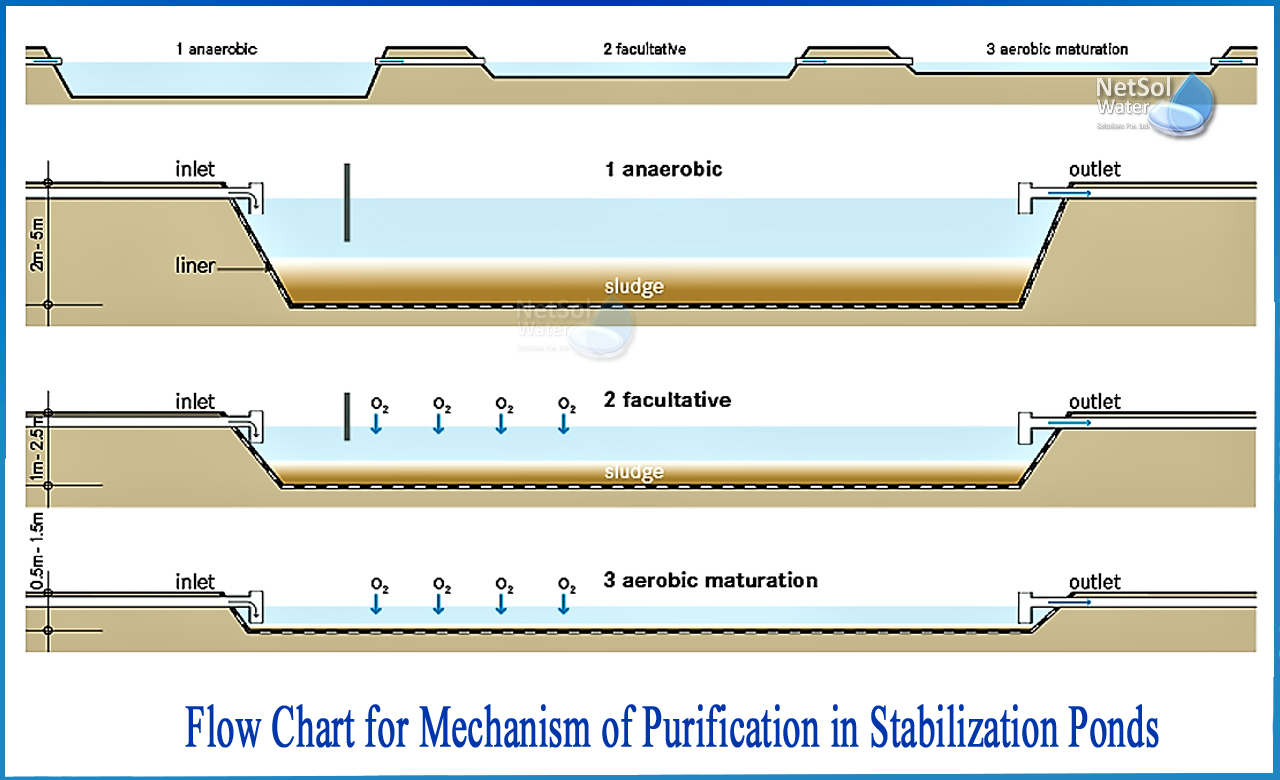What is the mechanism of purification in stabilization pond?
Waste Stabilization Ponds (WSPs, also known as stabilization ponds or waste stabilization lagoons) are ponds used to treat wastewater in order to reduce organic content and eradicate pathogens. They are huge, man-made water bodies in which natural processes including the effect of sun light, wind, bacteria, and algae cure blackwater, greywater, or faecal sludge. The ponds can be used separately or in a sequence for better treatment.
What are the types of Stabilization Ponds?
Anaerobic, facultative, and aerobic (maturation) ponds are the three types of ponds, each having its own treatment and design characteristics. For BOD, WSPs are low-cost, and pathogen elimination is high. Because the effluent still contains nutrients (such as nitrogen and phosphorus), it is suitable for re-use in agriculture but not for direct recharge in surface waterways.
Application and suitability of Stabilization Ponds
Waste stabilization ponds are particularly effective in removing organic materials and, under some circumstances, harmful organisms. Their design requirements haven't changed much over time. Ponds are easy to design, construct, run, and maintain, which is critical in rural places and underdeveloped countries where sophisticated technology and highly qualified workers are few. In small communities, construction may be done by local contractors.
Treatment of Wastewater with Waste Stabilization Ponds
Waste stabilization ponds can treat almost any sort of wastewater and work effectively in almost any environment. They are especially well-suited to tropical and subtropical countries, where the intensity of sunshine and temperature are important variables in the removal processes' efficacy. Ponds are found all throughout the world. As a result, they are one of the WHO-recommended procedures for treating wastewater for reuse in agriculture and aquaculture, owing to their efficacy in eliminating nematodes (worms) and helminth eggs.
Ponds are not very efficient in removing organic debris, and they have limited capacity for removing nitrogen and phosphorus. Because of the algal production in the ponds, the effluent frequently contains high suspended solids concentrations. As a result, unless extra stages of post-treatment are included, ponds are not a suitable technology in places with severe discharge criteria.
Ponds demand a lot of space, thus they might not be feasible in locations where land is pricey. In order to cut building expenses, a suitable topography and soil structure are also desired.
Mechanism of stabilization ponds
In many other nations, particularly in warmer climates, WSPs are the most frequent type of wastewater treatment systems. They can be used by alone or in conjunction with other wastewater treatment methods.
Treatment of wastewater happens as elements are removed by sedimentation or converted by biological and chemical processes in a typical system consisting of many built ponds running in series. A sludge layer forms at the bottom of the ponds, affecting performance by modifying the pond's hydraulics due to a reduction in the pond's effective volume and changes in the shape of the bottom surface. As a result, sludge removal is frequently required on a regular basis. Stabilization ponds for wastewater treatment are those that maintain the proper biological conditions for biological interactions and reactions that break down organic and inorganic nutrients.
Depending on the organic strength of the input waste and the effluent quality requirements, wastewater stabilization pond systems are intended to achieve different types of treatment in up to three stages in series.
Stage 1. Any design should have at least two parallel trains of ponds for simplicity of maintenance and operation flexibility. Strong wastewaters with a BOD5 content of more than 300 mg/l will typically be fed into first-stage anaerobic ponds, which have a high volumetric rate of removal. Weaker wastes, or even stronger wastes (up to 1000 mg/l BOD-5), may be discharged straight into primary facultative ponds if anaerobic ponds are not environmentally suitable.
Stage 2. The effluent from the first-stage anaerobic ponds will overflow into secondary facultative ponds, which are the biological treatment's second stage.
Stage 3.If more pathogen reduction is required after primary or secondary facultative ponds, maturation ponds will be installed to give tertiary treatment.
Mechanism of purification in Stabilization ponds

Technical assistance and guidance
Netsol Water have expertise in wide range of wastewater treatment technologies. We are the solution to every water and wastewater related problems and its management. If you need any advice or assistance on selecting the best wastewater treatment plant.



